According to new data from analyst firm Apptopia, as the COVID-19 pandemic spreads, grocery delivery apps have begun to receive a record number of daily downloads. Today’s grocery apps offer more than just shopping for products online: they allow businesses to increase their sales, enter a new market of active mobile users, learn more about their customers, and make targeted offers that increase conversion rates and therefore revenue.
In this article, we’ll discuss how to start a grocery delivery service by creating an app for your business, no matter if it’s a small store or a large chain.
Table of Contents
- 1 What is the grocery app?
- 2 Competitive business models for grocery shopping apps
- 3 Types of grocery apps
- 4 What are the most popular grocery delivery apps?
- 5 Benefits of grocery buying app development
- 6 Necessary features of online grocery app
- 7 Complete strategy on how to build a grocery app
- 8 Technology stack and requirements
- 9 How to monetize your own grocery delivery app?
- 10 Grocery app development cost
- 11 Challenges of grocery delivery app development during COVID-19 pandemic
- 12 The bottom line
What is the grocery app?
As the name suggests, grocery delivery apps allow customers to order groceries (or other items) to be delivered to their doorstep. The service itself is certainly not new, but the move to mobile devices has made it much more accessible and widespread. You don’t need to hire a domestic worker to deliver groceries. The only thing that is needed is just a couple of taps away.
Simply put, developing a grocery delivery app is like developing any other app that offers on-demand services. I.e., Uber. Uber has its on-demand food delivery service, Uber Eats. If you decide to start a grocery delivery business in the US, Uber Eats will be one of your main competitors.
Market trends and overview
Before diving into the technical aspects, let’s overview market size, current trends, and some statistics.
The COVID-19 pandemic is pushing consumers to buy products digitally. It is rapidly accelerating the adoption of online grocery services in the US. Thus, while the pandemic has given a big boost to the proliferation of online grocery stores, the industry’s resilience will depend on the duration of the pandemic. Let’s look at some numbers.
- Mobile apps are the primary tool for online grocery shopping. In early April 2020, global app downloads for grocery shopping reached 106 million per month. Walmart reported the highest number of downloads in April and was ranked #1 and #2 on the Google Play Store and Apple App Store, respectively.
- According to CNBC, it is expected that by 2025 sales will successfully capture 20% of the market. Other statistics show that the use of mobile apps for grocery stores will increase by 50% in the nearest time.
- 48% of grocery customers currently buy at least some of the items online.
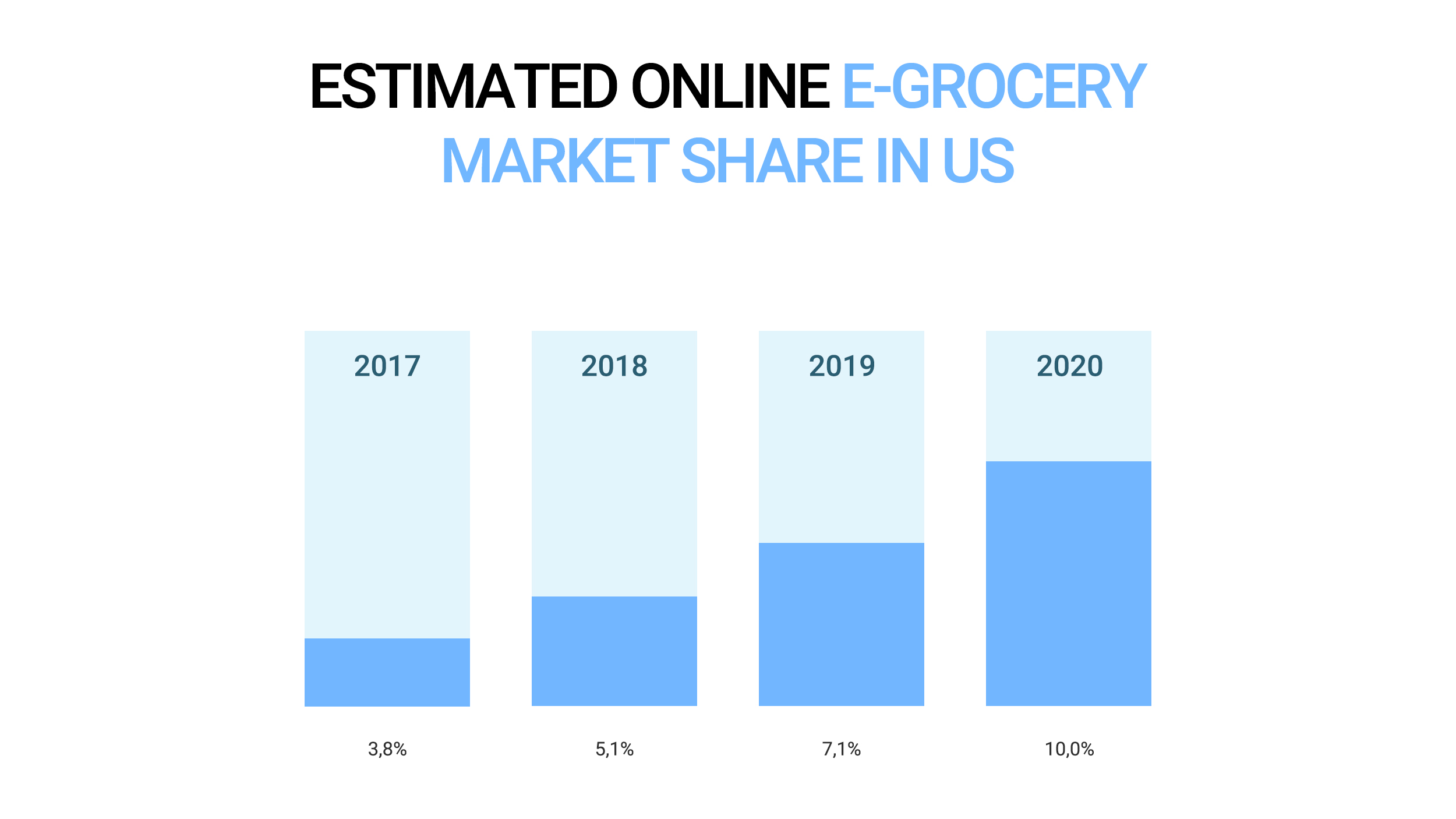
Competitive business models for grocery shopping apps
If you are interested in grocery delivery app development, here are the different business models you can use.
Inventory model
This model supposes storing products directly from different suppliers. You receive orders from customers and deliver them through an internal or external supply chain. Orders are delivered to consumers with the site logo, regardless of the sellers.
Multi-vendor marketplace model
The stock is not processed by the platform. Instead, it connects consumers with nearby grocery stores. The order is placed on the website by the customer and converted to his grocery stores on that website. Transportation is carried out by an internal logistics network that collects the goods and dispatches them to the customer. With appropriate store branding, the company delivers orders to consumers.
Shopping model
The shopping model is the most widespread one. Almost all giants choose it. It works the same as the multi-seller model, except that consumers do not choose the store they want to buy from before placing their order. The application controls its distribution network. Once an order is placed, the company transmits information to its suppliers, whose task is to buy and distribute goods to their customers. Instacart follows this model.
Hyperlocal model
The hyperlocal structure is the buzzword in e-commerce. The success of hyperlocal e-commerce websites has taken on a radically new dimension with product distribution, grocery ordering, home shopping, personal care services, and more. The USP of hyper-local e-commerce firms is their willingness to sell surprisingly fast products and services. Hyperlocal distribution models promise their customers that the items they purchase will be picked up within an hour.
Types of grocery apps
If you are interested in creating a grocery delivery app for your business, keep in mind that there are several possible options. Below we listed the most common types of grocery apps.

Marketplace apps have their menus and delivery drivers to take orders and deliver food to your doorstep. If you haven’t had a grocery business before, but want to try, then it is the most suitable form.
☑️Aggregator
All local stores and their menus are identified by aggregators. This kind of application allows you to create specified stores at the request of the user. They hire partner drivers to deliver the goods, but product performance depends on the store. Instacart, popular in the US, and Flipkart’s competitive grocery app in India are one such example.
☑️Grocery chains
Major retail store apps like Walmart have consumers with their apps. Apps allow consumers to conveniently order food and deliver it home.
☑️Individual stores
These apps, developed by individual retailers, are exclusively for the daily customers of the store. They are all managed by one store, application creation and administration, and distribution.
What are the most popular grocery delivery apps?
There are many online grocery delivery business applications that are gaining tremendous success and popularity day by day. Among them are:
Instacart
Instacart is one of the leading online grocery shopping sites, currently serving 26 states and the District of Columbia. The app connects customers with freelance shoppers who bring them groceries from any of their preferred supermarkets such as Costco Whole Foods and Petco. Instacart Express membership is $149 per year, which translates to about $12.50 per month.
AmazonFresh
It is a leading grocery delivery service currently available in select US states, Tokyo, Berlin, London, Munich, and Hamburg. It allows people to choose from over 500,000 items and receive them the same day. AmazonFresh also offers early morning delivery and dispatch within the requested 2-3 hour pick window.
Vons
Vons is a Southern Nevada and Southern California supermarket chain that operates stores under the Pavilions and Von’s banner. The main advantage of the app that it is faster and easier than other services.
Peapod
Peapod is one of the best online supermarkets in Illinois, Chicago. It delivers groceries from the company’s stores and warehouses in the Chicago area. Peapod currently operates in the District of Columbia and 13 US states. Peapod offers over 12,000 different products such as organic food, convenience food, gourmet, and seasonal products.
Benefits of grocery buying app development
Shopping online through grocery apps is nothing new, but the current global situation has made it an absolute must. Here are some of the benefits of using apps for groceries during the COVID-19 pandemic:
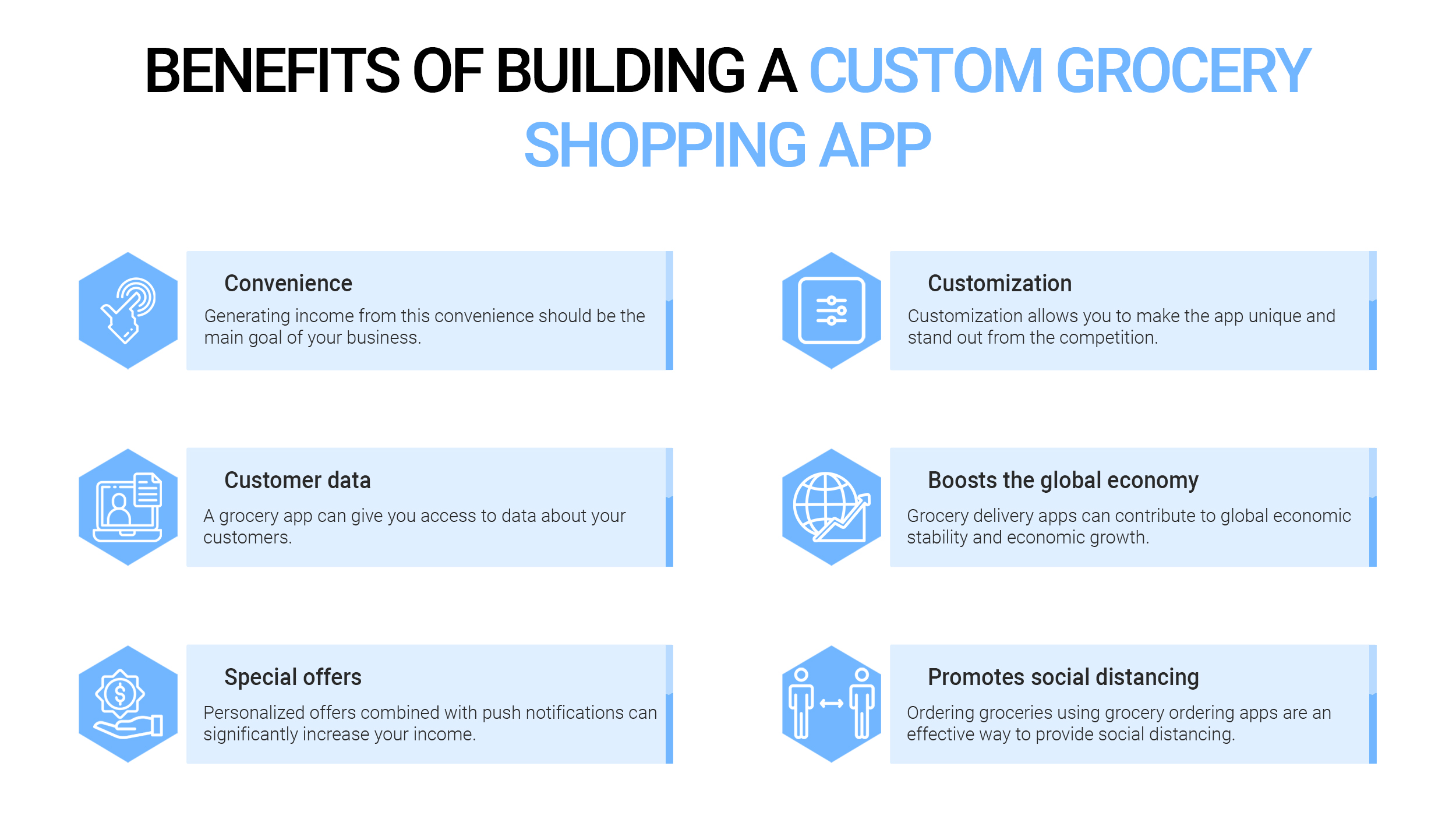
Convenience should be the key focus of your mobile product. Generating income from this convenience should be the main goal of your business. To make your software as user-friendly as possible, you need a smart product app UX design that keeps the user’s journey as short and smooth as possible.
✓Customer data
A grocery app can give you access to data about your customers that you would never have been able to get without the app. I.e., the devices customers use, the products they buy from your store, behavior, habits, preferences. Thus, you can customize analytics as you want and collect data about the way customers interact with the business through the app.
✓Special offers and increased conversions
After collecting customer data, you can target specific customer groups with customized offers, discounts, and promotions. Using algorithms, you can predict what products your customers are currently interested in, what makes them choose a particular product, and more. Personalized offers combined with push notifications can significantly increase your income.
✓Customization
It is the most obvious advantage of any custom development: the ability to create exactly what you need and scale or modify your product the way you want. Customization allows you to make the app unique and stand out from the competition with a simpler and more versatile mobile solution.
✓Boosts the global economy
Grocery delivery apps can contribute to global economic stability and economic growth by creating jobs for daily rates and delivery staff.
✓Reduces loss of goods
Grocery apps can play a pivotal role in optimizing grocery store supply chain and inventory management to help reduce food waste.
✓Promotes social distancing
Ordering groceries using grocery ordering apps are an effective way to provide social distancing. What’s more, it can prevent the transmission of the virus, providing users with a safe and convenient shopping experience.
Necessary features of online grocery app
Now let’s discuss the features you’ll need to make it easier for your buyers to purchase products.
Customer app role features
Registration
The registration should be simple and comfortable. Providing instant access to customers through multiple social media profiles can be a great way to keep them and attract more visitors.
Improved product search
Integrating smart search into your on-demand grocery app is inevitable as it will help users find preferred products with specific keywords without having to navigate the entire app.
A wish list
This feature will help the customer save the desired products for future purchases. Buyers can add items to their wishlist and buy them later.
Shopping cart exchange
This is a great feature for increasing the cost of the cart and reducing the number of abandoned carts. Customers can share their shopping carts with friends and family through the cart sharing feature.
Recommendations
This feature will display a list of recommended products based on the user’s previous search preferences. What’s more, providing targeted product recommendations can play a key role in increasing the average order value for your store.
Price comparison
It is another must-have feature that will help people know what other brands are pricing for similar products. This feature will allow buyers to compare similar products.
Self-pickup
This feature is also known as “click and collect”, which allows people to place an order online and schedule a pick-up at the store if it is comfortable for them.
Tracking order and delivery
The real-time tracking helps users know the status of their order, from order dispatch to estimated delivery time.
Multilingual functionality
Adding a multilingual feature can help you expand your customer base across multiple regions and stay ahead of your competitors.
Repeat orders
It will help your grocery customers quickly select regularly used products from their purchase history.
Voice search
Adding voice search can play a key role in improving the user experience. It will allow people to use a voice command to place an order or search for a product.
Delivery planner
It allows people to schedule delivery ahead of time as they see fit. Customers can choose a delivery date for their order during the checkout process.
Push-up notification
It’s an awesome feature for increasing customer engagement and launching app usage. Push notifications allow keeping your customers informed of flash sales, current promotions, and discounts.
Multiple payment options
Multiple payment methods will make your customers feel the ease of making payments quickly.
Coupon codes and rewards
Most customers are always looking for discounts and deals. Thus, the integration of coupon codes and loyalty reward programs will increase user engagement and encourage people to buy more.
Simple checkout process
This feature is vital to creating an exceptional shopping experience for consumers. A simplified checkout process will help users place an order in a few easy steps and increase conversion rates.
Rating and reviews
Customers can use feedback and rating systems to share their shopping and browsing experiences. This feature will play a key role in building trust among customers.
Courier app role features
Registration
The courier can register with the grocery delivery app by filling in a few details such as name, email address, and phone number. You can also enable social media profiles to provide instant access to applications.
Profile management
This feature will help effectively manage profiles. Thus, the couriers can easily update their profile by adding personal details, uploading a profile picture, and adding bank account details.
Wallet management
This option will allow managing all of their payments and virtual credits. Messenger can also check and manage withdrawal requests using this feature.
Order management
The courier will be able to check the number of orders placed, manage the delivery status of an order, and accept or reject order requests.
Notification
Notifications will appear on the buyer’s device when an order is placed or shipped for delivery. With this feature, buyers, suppliers, and couriers will receive order status emails, cancellations, funds and replacement requests, withdrawal request emails, gift card emails, exchange and receive emails, etc.
It is one of the crucial features by which the courier finds out the location of the client via GPS. The messenger can find the best route options to make it easier to deliver multiple orders through route optimization.
Delivery history
The courier can check his order delivery history, how many orders he delivered in a day, or even the total number of order requests to date.
Earning status
This feature will help track their earnings. What’s more, couriers will be able to transfer their earnings to their bank account as needed.
Admin app role features
Store management
The administrator can manage all aspects of the store from one place.
Coordination with store owners
An administrator can instantly coordinate with managers and maintain a smooth workflow.
Product list management
The administrator can manage and even control the list of products and adjust prices by market standards and the requirements of store owners.
Order tracking
The administrator monitors each order of processing, and for a systematic process, he monitors the workflow.
Client management
The administrator should be able to manage clients and engage them to their needs by sending regular notifications and notifying them from time to time.
Testimonials
The administrator collects all reviews and ratings to act following them to improve the quality of customer service.
Notification
The administrator sends a notification to provide customers and store managers with the order status.
Payment management
The online grocery solution admin panel also manages the payment model.
Complete strategy on how to build a grocery app
There are several steps to create an awesome grocery delivery app. Here is the list of the main of them.
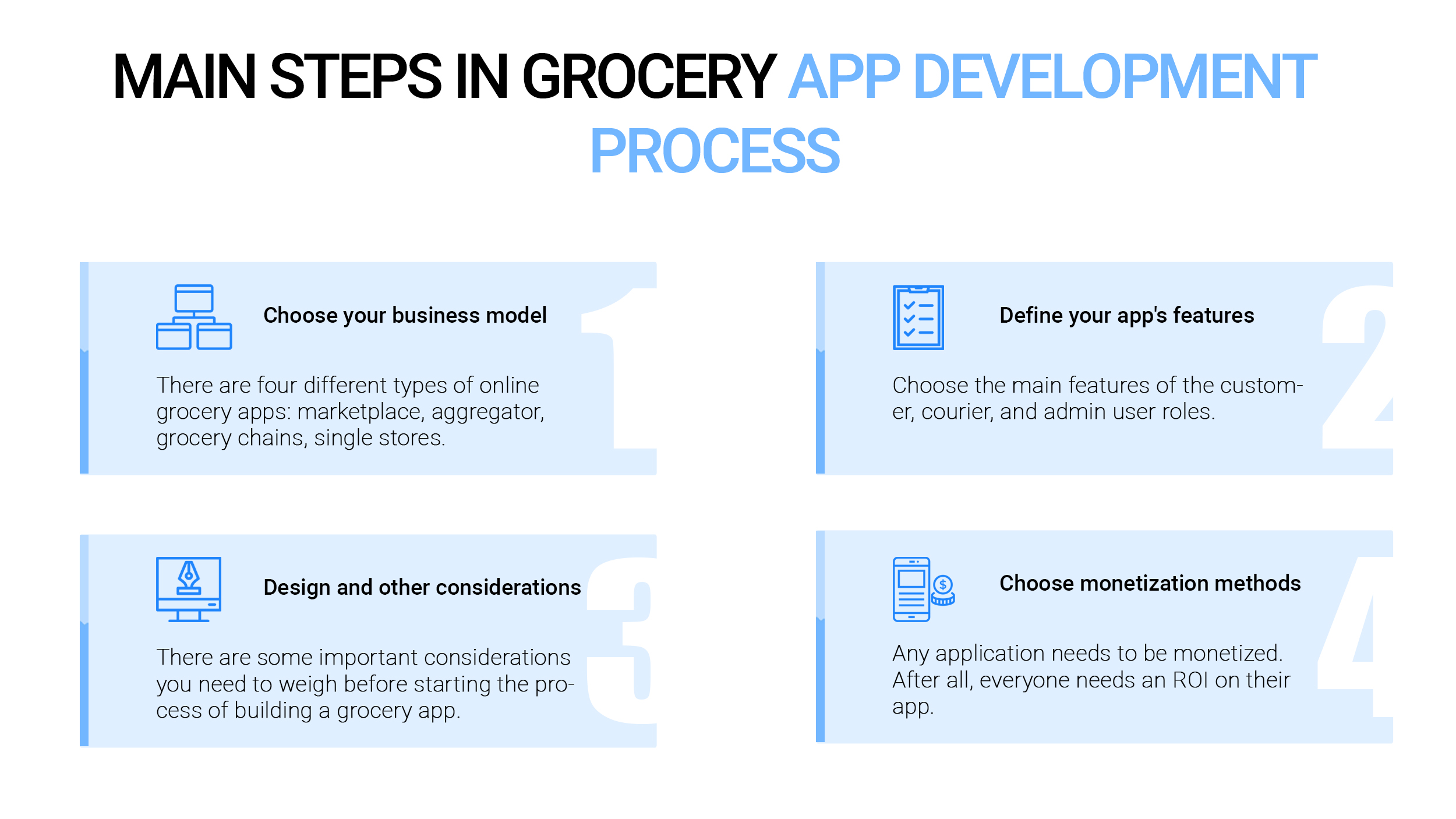
As we told above, there are four different types of online grocery apps: marketplace, aggregator, grocery chains, single stores. Each of them has some specialties. Thus, you need to choose the one that suits your business goals the best.
Step #2: Define the features you want to offer in your apps
You can’t just build one grocery store app. When it comes to the growth of on-demand grocery apps, there are three sides to an app: customer, courier, and admin. The main features of all these roles we discussed above.
Step #3: Design and other considerations
There are some important considerations you need to weigh before starting the process of building an on-demand grocery app. It would make it easier for you to prepare and sell the application to the client. Moreover, it ensures that the app is more distinctive than your competitors.
Step #4: Choose monetization methods
Any application needs to be monetized. After all, everyone needs an ROI on their app. But along with the kind of application you create, the methods of monetization also change. When it comes to food delivery apps, many are asking how to make money with apps like Instacart.
Technology stack and requirements
Creating good apps requires the right technology. So, below we have listed a technology stack that will help you move forward in food delivery application development.
| Front-end | React.js/Angular/Vue.js |
| Back-end | Typescript, Next.js, PHP, Laravel |
| Mobile platform | Android, iOS |
| Real-time analytics | IBM, Apple Flink, BigData, Cisco, Spark, Hadoop |
| Database | Postgress, HBase, MongoDB, Cassandra |
| Payments | e-Wallets, Stripe, PayPal, Braintree |
| Voice, SMS, & Phone Verification | Twilio, Nexmo |
| Push Notifications | Push.io, Twilio |
| Cloud Environment | Azure, Google, AWS |
| Third-party services | Mail Chimp Integration |
| GPS navigation | MapKit, Google Maps API |
Now, when you are familiar with the tech stack let’s move on to the main monetization strategy.
How to Create Your Own Music Streaming App That Brings Clients
How to monetize your own grocery delivery app?
On-demand grocery delivery services need to be not only convenient but also inexpensive to grab the attention of users. Let’s take a look at a few of the monetization channels that allow Instacart to generate revenue while remaining available to customers.

Almost any grocery delivery app charges users a fee to deliver orders to their doorstep. A percentage of the commission goes to the couriers and the rest goes to the company. Also, there may be additional charges for orders where the estimated total weight is bigger than a certain number.

Membership is another monetization channel that offers significant benefits to customers. Benefits may include free shipping, requesting items from multiple stores in a single order with no commissions, reduced service fees, no pickup fees, etc.

Grocery delivery apps generate revenue by promoting partner stores or certain products. Stores benefit from the huge user base, and the company makes a profit every time a shopper interacts with a promoted product.

Gift cards are an awesome way to monetize your grocery delivery app and get a chance to attract new customers.
Grocery app development cost
The total cost of grocery app development depends on many factors. Here is the list of the ones that influence the most: the complexity of the application, size of the development team, the developers’ location. If you want to see the more accurate cost of grocery app development, you can follow the table below where we have mentioned the approximate time it takes developers to build applications. Take a look!
| Scope | Approx time, hours |
| 1. Project Start | |
| Initial backlog preparation | 20 |
| Project Schedule Preparation | 20 |
| Staging environment setup | 23 |
| 2. Front-end | |
| Registration, log in | 20 |
| Forgot your password | 9 |
| Entering location | 14 |
| Personal information | 11 |
| Home | 16 |
| Navigation | 11 |
| My orders | 23 |
| My coupons | 9 |
| Delivery addresses | 8 |
| Category view | 12 |
| Product selection | 12 |
| Basket | 17 |
| Checkout | 17 |
| Scoring and complaints | 12 |
| 3. Back-end | |
| Registration | 12 |
| Forgot your password | 12 |
| Location checks API | 22 |
| Log in | 24 |
| My orders | 11 |
| My coupons | 17 |
| Orders API | 15 |
| Orders: products data | 27 |
| Checkout, payment | 20 |
| 4. Stabilization and Delivery | |
| Prepare deployment docs | 11 |
| Prepare description docs | 43 |
| 5. Project management | |
| Backlog elaboration and maintenance | 14 |
| Planning meetings, review meetings | 21 |
| Project Management and communication | 22 |
| Quality Assurance, hours: | 101 |
| Total Development, hours: | 405 |
| Project Management, hours: | 120 |
| Total: | 626 |
Challenges of grocery delivery app development during COVID-19 pandemic
COVID-19 pandemic has rapidly changed people’s habits. To help your buyers stay calm about their health, we suggest using the following strategies.
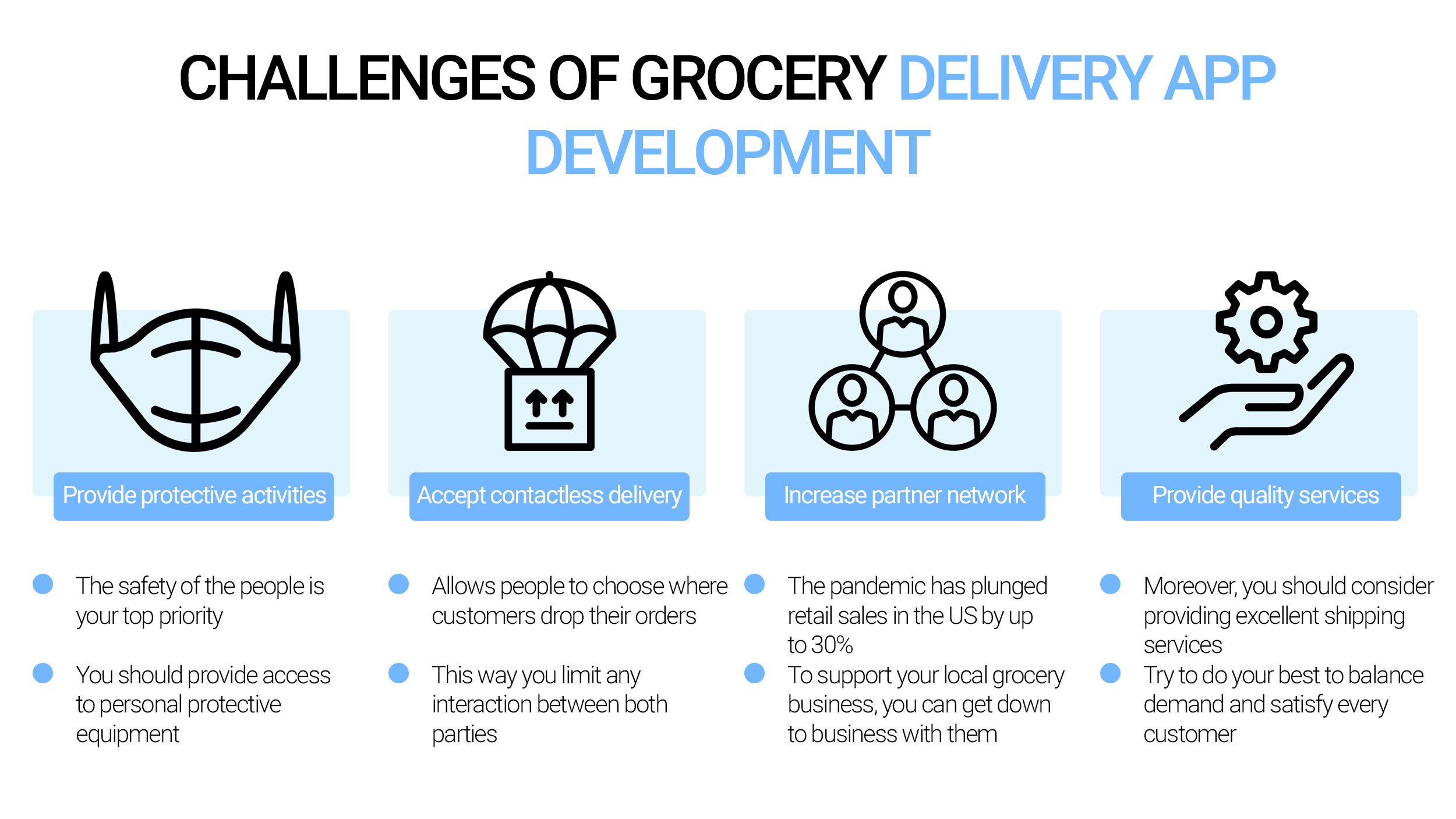
- Provide protective activities
The safety of the people is your top priority. To keep them safe, you should provide access to personal protective equipment. I.e., masks, respirators, gloves, and hand sanitizer. Besides, employees should wash their hands as needed and clean frequently used equipment once an hour.
- Accept contactless delivery
Contactless shipping allows people to choose where customers drop their orders: near the doorstep, in front of the house, etc. This way you limit any interaction between both parties.
- Increase partner network
The pandemic has plunged retail sales in the US by up to 30% and many brick-and-mortar stores lack the resources to run their online business. Thus to support your local grocery business, you can get down to business with them, which is a win-win situation for both your grocery ordering app and local grocery stores.
- Provide quality services
Moreover, you should consider providing excellent shipping services. They may include late delivery, 24/7 service, a wide variety of delivery windows, and fresh produce on every order. Quality delivery services will make the difference, especially after security is no longer an issue. Thus, try to do your best to balance demand and satisfy every customer.
The bottom line
On-demand grocery delivery app is one of the most promising niches to explore in 2022. Vitality can be a key to your business’s success. By complementing high-quality software with compelling offerings, offering high rates to buyers, and using a customer-centric approach, you have a real chance to grow a powerful company.
At the early stage of your brand development, the main task is to find a reliable team with sufficient experience in the development of delivery services. If you are looking for a partner, please contact us. We will be glad to help you in creating a market-leading grocery delivery app.
✔Read next:
How to Make an App like Clubhouse: Features, Tech Stack, Cost
How to Make an App Like OnlyFans: Features, Steps, Cost
How to Make a Video Calling App Like Zoom and Google Hangouts?
Online Pharmacy App Development: Complete Guide

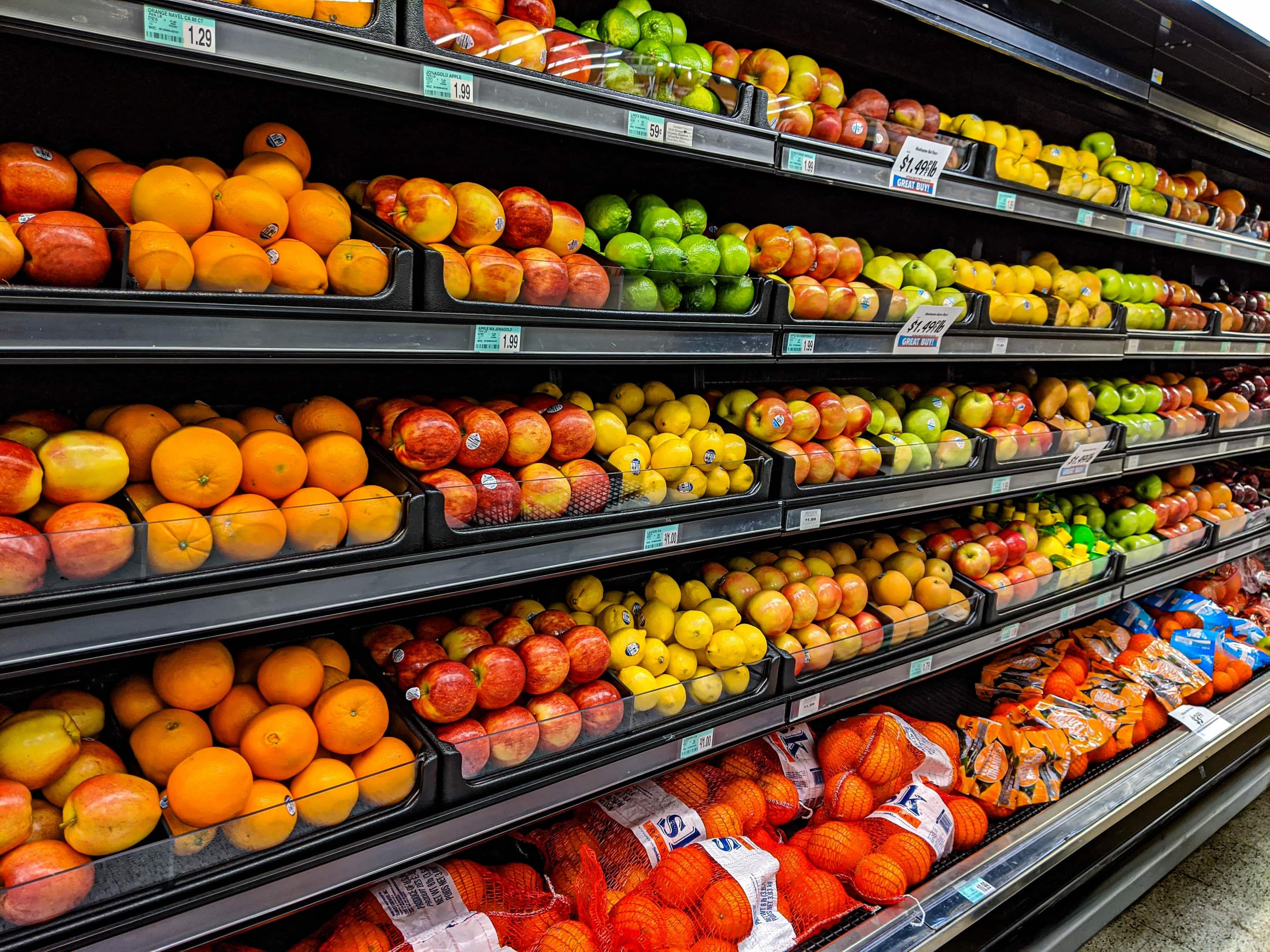














Popular
Latest
like your article thanks a lot!